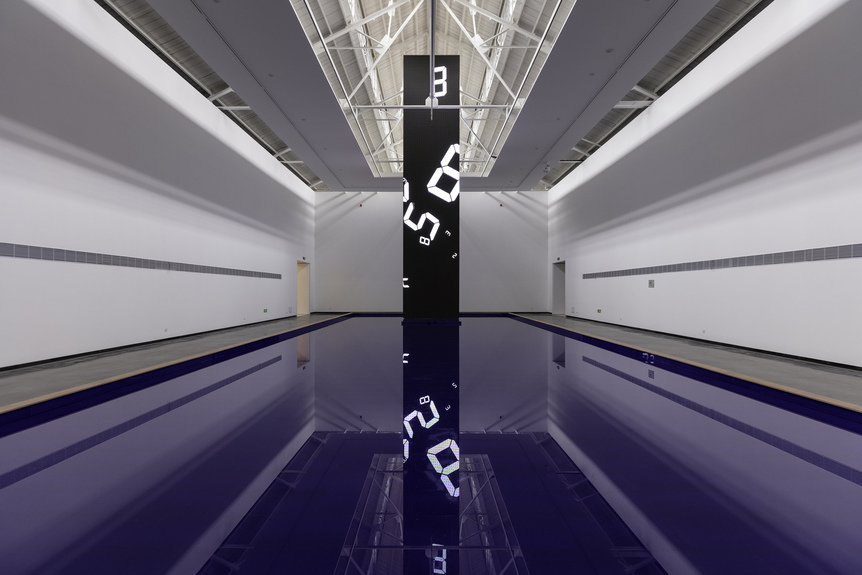-
From Current Issue
-
- Editor’s Letter Fire in the Heart
- Reviews I Gusti Ayu Kadek Murniasih
- Reviews 11th Seoul Mediacity Biennale: “One Escape at a Time”
- Dispatch Networked China
- One on One Monira Al Qadiri on Yukio Mishima
- Essays The rise of independent art spaces in pandemic-era Shanghai
- Features Tuan Andrew Nguyen
- Table of Contents
- Web Exclusives
- Archive
- Subscribe

R
E
V N
E
X
T
Installation view of TATSUO MIYAJIMA’s “Being Coming” at Minsheng Art Museum, Shanghai, 2019. Copyright the artist. Courtesy Minsheng Art Museum.
In a 1925 article published in the German newspaper Vossische Zeitung, journalist and satirist Kurt Tucholsky recounts a joke in which a French diplomat quips, “The death of one man: that is a catastrophe. One hundred thousand deaths: that is a statistic!” The sentiment of this oft-misattributed comment resounded in “Being Coming,” an extensive survey of Tatsuo Miyajima. Due to the artist’s consistent incorporation of the digital LED counter in his works, numbers overwhelmed the viewer in unremitting, ever-changing panels. Miyajima has used this motif since the beginning of his artistic career in the 1980s—when computer processing power was modest, and such numerical magnitudes were, to most, beyond understanding—as a means of probing Buddhist notions of change, recurrence, and infinity. Now, the distance to other galaxies, the age of the earth, the quantity of mineral reserves, and projected impacts of various disaster scenarios are widely perceived to be accountable to a fair degree of accuracy. Today’s viewer is likely inured to the onslaught of abstract numbers, which are frequently manipulated in the service of competing interests. It is in this context that “Being Coming” took on more urgent resonances beyond spiritual reflection.
Insistently repeated, the counter’s many forms begin to feel anodyne, as in the monumental Time Waterfall (2019), in which luminous digits tumble across the surface of a dark obelisk, reflected in the vast ultramarine pool in which the structure is installed. In Counter Gap (2019), numbers blink in a dark void; arranged in a six-meter horizontal line, the counters produce a bewilderingly great figure. By contrast, Counter Coal (2008) features tiny red numerals, winking like embers, within a mountain of the titular fuel. Elsewhere, Life (le corps sans organes) (2013) comprises a series of circuits, each hosting a single counter, all wired together like a multicellular organism clinging to the wall and creeping onto the floor. Each counter’s scrolling number is inexorable, bringing to mind the recursive Fibonacci sequence that appears in certain natural patterns of growth, and thus appearing to tie mathematics to the origins of organic life.
The generous space within the revamped Minsheng Museum allowed the exhibits to be dispersed sparingly, though the multitudes of numbers were no less confounding. The works create a unified impression of numbness and detachment arising from the propensity to quantify. The negation of the individual by data is exemplified by Archive of Deathclock (2013), composed of blurry, monochrome headshots, mounted side-by-side and stretching down long corridors. For Archive, participants guessed the day they would die; the dates chosen, rendered as an inscrutable row of numbers, are superimposed onto the portraits, turning the subjects’ optimism (in the case of those who expected a long, healthy life span) and pessimism (those who presumed a premature demise) into blunt, repetitious, numerical functions.
Even in works where numerical displays do not feature, the counter’s basic functionality, reckoning from 0 to 9, remains. The most compelling of these works deploy people to enact the counter’s sequence. In both of the performance videos Clear Water (1996) and Counter Voice in the Water at Fukushima (2014), actors recite strings of numbers, plunging their heads into bowls of water at the end of each count. The earlier work shows performer Akio Nagasawa gasping for air, mucus streaming from his nose between compulsive immersions. When the procedure of the LED counter is imposed on humans, its neutral mechanism becomes a merciless order. A recent version, Counter Voice in Chinese Ink (2019), is all the more troubling, with clear water replaced by dense, viscous ink. A shirt worn by the actor during the performance is presented at the exhibition—chilling proof of compliance in the torturous process of asphyxiating submersion.
Despite the exhibition text’s assertion that Miyajima’s motivation is arcane spirituality, his acts of counting urge intervention; they appear to remind us that when large numbers are deployed to obfuscate the value of individuals, we are free to reject their seductive inscrutability and refuse their dominion.
Tatsuo Miyajima’s “Being Coming" is on view at the Shanghai Minsheng Art Museum until August 18, 2019.
To read more of ArtAsiaPacific’s articles, visit our Digital Library.



















